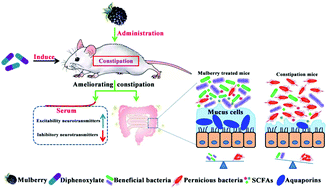Protective effect of mulberry (Morus atropurpurea) fruit against diphenoxylate-induced constipation in mice through the modulation of gut microbiota
Abstract
Mulberry (Morus atropurpurea) has long been used to treat gastro-intestinal ailments; however, the functional basis of its therapeutic effects remains unclear. The aim of this study was to measure the effects of mulberry (administered by gavage) on diphenoxylate-induced constipation in mice and elucidate the mechanisms underlying these effects using constipation and physicochemical indexes, histological morphology and 16S rDNA amplicon analysis of fecal microbiota. Sixty Kunming mice were randomly divided into the following six groups (n = 10 per group): normal control, constipation model, positive control, and low-, mid- and high-dose mulberry groups. After 14 days of treatment, constipation was induced over 5 days and measurements were conducted. The results show that mulberry treatment prevented constipation by increasing the fecal water content, shortening the first red fecal defecation time, promoting gastric evacuation, and increasing the gastric-intestinal transit rate (P < 0.05). Compared with the constipation model group, the mulberry-treated groups showed decreased aquaporin gene expression (Aqp3, Aqp4, Aqp8 and Aqp9), decreased serum levels of inhibitory neurotransmitters (nitric oxide and vasoactive intestinal peptide) (P < 0.05), and increased serum levels of excitability neurotransmitters (acetyl choline, substance P, and motilin). The histological morphology of the colon showed that mulberry treatment increased the number of mucus cells (P < 0.05). Mulberry treatment also increased the concentrations of acetic, propionic, butyric, valeric and isovaleric acids (P < 0.05), increased the abundance of Lactobacillus and Bifidobacterium in feces, and decreased the abundance of Helicobacter and Prevotellaceae in feces. Our findings indicate that mulberry consumption effectively prevents constipation in mice and is a promising therapeutic candidate for constipation.


 Please wait while we load your content...
Please wait while we load your content...